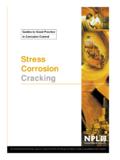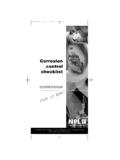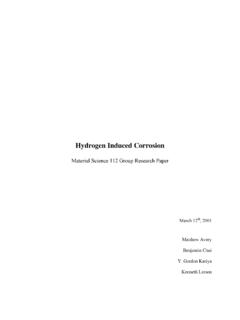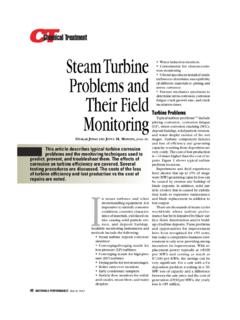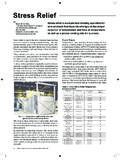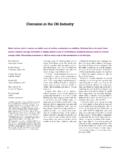Transcription of Chloride stress corrosion cracking in austenitic …
1 Prepared by the Health and Safety Laboratory for the Health and Safety Executive 2011 Health and Safety ExecutiveChloride stress corrosion cracking in austenitic stainless steelAssessing susceptibility and structural integrityRR902 Research ReportR Parrott BSc PhD MIMMM CEngH Pitts MEng PhDHarpur HillBuxtonDerbyshireSK17 9 JNChloride stress corrosion cracking (CLSCC) is one the most common reasons why austenitic stainless steel pipework and vessels deteriorate in the chemical processing and petrochemical industries. Deterioration by CLSCC can lead to failures that have the potential to release stored energy and/or hazardous substances.
2 Failures of plant can be prevented by an awareness of the onset and evolution of CLSCC, and by periodic inspection to monitor the extent of cracking . Although the deterioration of austenitic stainless steels by CLSCC is well known, recent incidents and inspection visits by HSE have found that susceptibility assessments were inconsistent and did not always take account of current knowledge. Discussions between HSE, dutyholders and competent bodies identified that the technical justification for setting inspection intervals and the effectiveness of periodic non-destructive examination (NDE) for monitoring CLSCC were additional areas of concern.
3 This report and the work it describes were funded by the Health and Safety Executive (HSE). Its contents, including any opinions and/or conclusions expressed, are those of the authors alone and do not necessarily reflect HSE stress corrosion cracking in austenitic stainless steelAssessing susceptibility and structural integrityHSE BooksHealth and Safety Executive Crown copyright 2011 First published 2011 You may reuse this information (not including logos) free of charge in any format or medium, under the terms of the Open Government Licence. To view the licence visit , write to the Information Policy Team, The National Archives, Kew, London TW9 4DU, or email images and illustrations may not be owned by the Crown so cannot be reproduced without permission of the copyright owner.
4 Enquiries should be sent to authors wish to acknowledge the assistance of: (i) The chemical manufacturing company for providing detailed background information on the operation of two stainless steel reactors that developed Chloride stress corrosion cracking . (ii) The company s insurer for supplying details of a metallurgical investigation carried out on the reactors. (iii) Mitsui-Babcock who carried out an assessment of NDE techniques on samples from the CONTENTS 1 1 Background.
5 1 austenitic stainless 2 CLSCC mechanism .. 2 Factors affecting CLSCC .. 4 Controlling CLSCC .. 5 2 7 Susceptibility assessment for CLSCC .. 7 Structural integrity 12 Non-destructive examination .. 13 3 cracking OF THE 15 History .. 15 Discussion of CLSCC in the 16 4 AN ASSESSMENT OF NDE TECHNIQUES FOR 19 Background .. 19 Conclusions from the NDE ssessment .. 19 Overview of NDE issues for 19 5 LITERATURE REVIEW .. 21 Current understanding of the CLSCC 21 Practical cases of CLSCC below 600C .. 24 Effect of testing 28 Environmental factors.
6 30 Other factors .. 34 Metallurgical 35 6 39 CLSCC in the 39 From the literature review .. 40 7 APPENDICES .. 41 Appendix 1 Metallurgical examination .. 41 Appendix 2 - Engineering assessment .. 43 8 47 iiiiv EXECUTIVE SUMMARY Objectives Chloride stress corrosion cracking (CLSCC) is one of the most common reasons why austenitic stainless steel pipework and vessels deteriorate in the chemical processing and petrochemical industries.
7 The objectives of this work were: To draw conclusions and give recommendations for best practice in assessing susceptibility to CLSCC and in applying risk based inspection (RBI) to existing plant, in particular setting inspection intervals and carrying out non-destructive examinations (NDE). To assess a case of extensive deterioration from CLSCC in austenitic stainless steel reactor vessels that operated at ambient temperature. This part of the work included metallurgical testing and an engineering critical assessment of the reactors structural integrity.
8 To review NDE techniques for detecting and sizing CLSCC based on trials carried out by Mitsui-Babcock with samples from one of the reactors. To review literature on published cases of CLSCC at near ambient temperatures and of factors affecting the mechanism of CLSCC. The purpose of the review was to assess published data as a basis for control measures and for RBI decisions in the management of CLSCC. Recommendations for assessing susceptibility to CLSCC The susceptibility to CLSCC is usually assessed on the basis of Chloride content, pH and temperature.
9 In our view there are additional factors that should be taken into account when assessing the susceptibility with both new and existing pipework or vessels that have accumulated significant service. These include: Operation involves high temperature excursions. Susceptibility should be determined by the highest temperature reached during any part of duty or maintenance operations, irrespective of the duration of the excursion. Liquid can dry out allowing chlorides to concentrate or form Chloride -rich solid films.
10 Pitting and/or crevice corrosion already exist. The steel was manufactured before 1970 with possible higher levels of impurities. Possibility of sensitisation. Free machining grades. Surface finish has deteriorated since manufacture. Iron contamination of surfaces. Welding during manufacture, modification and repair. v Design or manufacturing details where chlorides can accumulate, roots of partial penetration welds.











